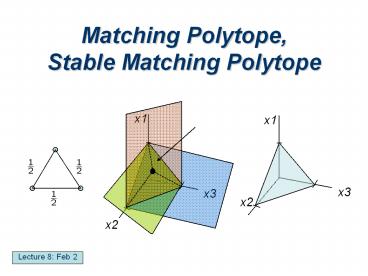Matching Polytope, Stable Matching Polytope - PowerPoint PPT Presentation
Title:
Matching Polytope, Stable Matching Polytope
Description:
if y is in the convex hull of. Prove: a vertex solution. corresponds to an. integral solution. ... Convex hull of matchings. Linear program. Define by points ... – PowerPoint PPT presentation
Number of Views:148
Avg rating:3.0/5.0
Title: Matching Polytope, Stable Matching Polytope
1
Matching Polytope, Stable Matching Polytope
- Lecture 8 Feb 2
2
Linear Programming
x1
x3
x2
x1
(0.5,0.5,0.5)
x3
x2
3
Good Relaxation
Every vertex could be the unique optimal
solution for some objective function.
So, we need every vertex to be integral.
For every objective function, there is a vertex
achieving optimal value.
So, it suffices if every vertex is integral.
Goal Every vertex is integral!
4
Black Box
Problem
Solution
Polynomial time
LP-formulation
Vertex solution
LP-solver
integral
5
Convex Combination
A point y in Rn is a convex combination of
if there exist
so that
and
6
Vertex Solution
A point y in Rn is a convex combination of
if y is in the convex hull of
Fact A vertex solution is not a convex
combination of some other points.
7
Maximum Bipartite Matchings
Prove a vertex solution corresponds to
an integral solution.
Every point in the polytope corresponds to a
fractional solution.
8
Maximum Bipartite Matchings
Prove a vertex solution corresponds to an
integral solution.
Pick a fractional edge and keep walking.
Because of degree constraints, every edge in the
cycle is fractional.
Partition into two matchings because the cycle is
even.
9
Maximum Bipartite Matchings
Since every edge in the cycle is fractional, we
can increase every edge a little bit, or decrease
every edge a little bit.
Degree constraints are still satisfied in two
new matchings.
Original matching is the average!
Fact A vertex solution is not a convex
combination of some other points.
CONTRADICTION!
10
Bipartite Stable Matchings
Input N men, N women, each has a preference list.
Goal Find a matching with no unstable pair.
How to formulate into linear program?
11
Bipartite Stable Matchings
Write if v prefers f to e.
Write
if
for some v
12
Bipartite Stable Matchings
CLAIM
Proof
13
Bipartite Stable Matchings
Focus on the edges with positive value, call them
E.
For each vertex, let e(v) be the maximum element
of
CLAIM
Let e(v) v,w
e(v) is the minimum element of
14
Bipartite Stable Matchings
For each vertex, let e(v) be the maximum element
of
CLAIM
Let e(v) v,w
e(v) is the minimum element of
e(w) defines a matching for w in W
W
U
e(v) defines a matching for v in U
15
Bipartite Stable Matchings
At top, blue is minimum, red is maximum.
W
At bottom, blue is maximum, red is minimum.
U
W
Prove convex combination.
U
16
Bipartite Stable Matchings
At top, blue is minimum, red is maximum.
W
At bottom, blue is maximum, red is minimum.
U
Degree constraints still satisfied.
Prove convex combination!
Bottom decreases, top increases, equal!
17
Bipartite Stable Matchings
Vande Vate
Rothblum
18
Weighted Stable Matchings
Polynomial time algorithm from LP.
Can determine if certain combination is possible.
Can work on incomplete graph.
19
Basic Solution
Tight inequalities inequalities achieved as
equalities
Basic solution unique solution of n linearly
independent tight inequalities
Think of 3D.
20
Matching Polytope
Matching polytope
Linear program
Convex hull of matchings
Intersections of hyperplanes
Define by points
Define by inequalities
P
Q
Goal Prove they are equal
21
Matching Polytope
Prove P is smaller than Q, and Q is smaller than
P.
Easy direction Check all points of P (i.e. all
matchings) satisfy all the inequalities
Another direction Check all points of Q (i.e.
all fractional solutions) is inside P.
How?
By showing that all points are convex combination
of vertices of P
22
Maximum Bipartite Matchings
Goal show that any fractional solution is a
convex combination of matchings
How?
By induction!
Bipartite perfect matching, 2n vertices.
Minimal counterexample.
23
Maximum Bipartite Matchings
An edge of 0, delete it.
An edge of 1, reduce it.
So, each vertex has degree 2, and there are at
least 2n edges.
How many tight inequalities?
At most 2n
How many linearly independent tight inequalities?
At most 2n-1
Basic solution unique solution of 2n linearly
independent tight inequalities
CONTRA!
24
Valid Inequalities
Odd set inequalities
Thats enough.
Edmonds 1965































